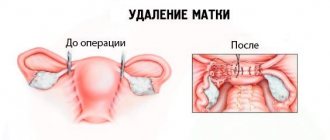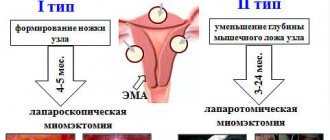A sick leave certificate is issued by medical institutions in the event of a patient’s incapacity for work. Each case of illness has a statutory duration of sick leave.
After surgical interventions, the human body does not always recover equally, so doctors are guided by the person’s condition and have the authority to release him from work for the required period of time. Let's consider how long they are on sick leave after removal of the uterus and other gynecological operations.
Dear readers! Our articles talk about typical ways to resolve legal issues, but each case is unique.
If you want to find out how to solve your particular problem, please use the online consultant form on the right or call. It's fast and free!
How long does disability last for gynecological interventions?
The average length of sick leave after surgery is 10 days. The reduction of this period or its extension depends on the severity of the operation and the presence of associated complications. According to severity they are distinguished:
Lungs - the patient is fully able to work and can start work the next day. BL is not issued. In some cases, a period of up to 3 days is provided.- Moderate – it takes time to recover, some bodily functions are impaired. Duration of BL is up to 30-45 days.
- Severe – after the main stage of treatment, a long rehabilitation period is required. BL for more than 45 days.
Gynecological operations are classified as light and moderate surgical interventions . Conditions after removal of oncology are considered severe if, according to histology (examination of removed tissue), a malignant tumor is confirmed. In this case, the doctor refers the patient to medical examination, where a disability group is assigned.
The essence of the problem
An operation involving the removal of the uterus is quite common , which is performed for very serious ailments that threaten a woman’s health. According to statistics, about a third of all women who have reached the age of 40 are forced to resort to such a procedure.
With any surgical intervention, injuries of varying severity occur, which are associated with damage to tissues and blood vessels. After a hysterectomy, damage also remains, and it takes time for the tissue to fully recover. The duration of postoperative rehabilitation depends on the severity of the disease, the type of surgery and postoperative complications.
Most often, removal of the uterus is indicated in the following cases :
- its loss;
- endometriosis;
- oncological diseases;
- metroendometritis, which cannot be treated;
- myomatous nodes;
- prolonged and heavy uterine bleeding.
Depending on the severity of the disease, the following types of operations are performed:
- removal of the uterus only;
- removal of the uterus and cervix (total extirpation);
- removal of the uterus with appendages and lymph nodes located nearby (radical panhysterectomy).
How severe the trauma will be depends not only on the type of operation, but also on the method of its implementation. The most radical is the abdominal technology, in which the walls of the peritoneum are cut, and another method is the vaginal method with an incision in the vagina. The least traumatic method is to remove the uterus using the laparoscopic method. In this case, a special laparoscope is used, which makes a very small incision. After laparoscopic surgery, complications are not so dangerous.
How long do you stay in hospital after a hysterectomy? It depends on the type of operation. After laparoscopy, the patient can be discharged the next day . If abdominal surgery was performed, the patient can go home after 2 to 3 days.
How many days of sick leave are given after different operations?
All days on sick leave are subject to payment . The exception is cases when the patient did not show up for an appointment on time or violated the regime, then the certificate of incapacity for work is closed in violation and the possibility of payment remains at the discretion of the employer.
Hysteroscopy
It is a minimally invasive surgical procedure and is often performed on an outpatient basis. If it is performed for diagnostic purposes and does not have complications, then the issuance of sick leave may be refused. For such manipulations, a period of 3 days is provided.
Cauterization of erosion
The procedure is always carried out on an outpatient basis, usually during an appointment with a specialist. After a preliminary consultation and tests, the woman comes for an appointment. The intervention lasts no more than 20–30 minutes. Immediately after graduation, she is able to work and can lead her usual lifestyle. Sick leave is not issued.
Conization of the cervix
It is a minimally invasive operation, but involves partial removal of the cone-shaped section of the cervical canal. Sick leave can last 5-15 days . This depends on the type of pathology for which surgical treatment was indicated and the extent of the intervention, since the removed area may differ in size in different cases.
It is often prescribed for dysplasia, which is one of the oncological pathologies, so a woman can be hospitalized in a specialized hospital (oncology) for diagnostic and treatment purposes. From there she is discharged either for further treatment and further examination at the place of residence, or with permission to work (when the patient’s case is closed by a hospital doctor).
Removal of uterine fibroids
The disease belongs to benign tumors. During surgery, when the fibroids are small, only part of the uterine tissue affected by the tumor is removed.
Usually the operation is performed laparoscopically (minimally invasively, through punctures in the anterior abdominal wall), so the sick leave period does not exceed 2 weeks. In some cases it can reach 30 days, but after 15 days the possibility of extension is decided by a medical commission .
Uterus removal
It is performed laparoscopically and laparotomically (through open access, by dissecting the anterior abdominal wall). The duration of the certificate of incapacity for work depends on the type of intervention.
How many days are given after removal of the uterus by laparoscopy and abdominal surgery? If a woman has undergone a laparotomy, the duration of sick leave after surgery to remove the uterus can be 45 days.
Activities for late rehabilitation
After the woman is discharged from the hospital, her recovery from the hysterectomy continues. The late stage of rehabilitation allows the body to fully recover. must be carried out:
- Wearing a bandage. After removal of the uterus, a special band helps support the weakened abdominal muscles. When choosing it, you should take into account this point - the width of the product should exceed the length of the scar by 12 - 15 mm at the top and bottom.
- You cannot lift objects heavier than 2.5 kg and you need to limit physical activity.
- Exercise therapy and gymnastic exercises. To strengthen the pelvic floor and vaginal muscles, it is recommended to perform Kegel exercises using a special exercise machine. You can start playing sports seriously 2.5 months after surgery.
- Baths, saunas and hot baths are strictly prohibited for the entire rehabilitation period. It is also better not to swim in open water.
It is very important to organize proper nutrition after removal of the uterus. A woman should not “push” and strain her abdominal muscles, so it is recommended to reduce the load on the intestines, trying not to eat aggressive and difficult-to-digest foods. The diet should be such that a laxative effect occurs.
The diet after hysterectomy includes the following permitted foods:
- crumbly porridge;
- green tea;
- vegetable oil;
- fresh vegetables and fruits (except grapes and pomegranates);
- mashed boiled vegetables;
- low-fat fermented milk products;
- boiled meat.
The diet after hysterectomy surgery prohibits the following dishes and foods:
- jelly, liquid porridge;
- chocolate, cocoa, coffee, strong tea;
- alcohol;
- fatty cottage cheese, pastries, white bread, sweets;
- white cabbage, peas and other legumes;
- smoked products - meat, fish, sausages, cheeses;
- oversalted, spicy, fatty and fried foods;
- semi-finished grocery products.
A diet after surgery should only be prescribed by a doctor.
What affects the duration of sick leave?
In an attempt to get a ballot, some people resort to tricks and invent symptoms that actually do not exist. With the help of ultrasound, MRI, tests and other diagnostic procedures, the doctor can reliably determine the presence of symptoms and make a decision on whether to open sick leave or deny it.
The duration of sick leave is determined:
- the need for hospitalization;
- the presence of complications and the risk of their development;
- complexity of the operation;
- volume of intervention.
Grounds for extending a certificate of incapacity for work
Complications of surgery may include:
bleeding;
- the addition of a secondary infection, with the subsequent development of inflammation;
- temperature increase;
- severe pain syndrome;
- failure of the postoperative scar (its divergence or suppuration).
How many days should it be extended?
The period for which a doctor can single-handedly issue a certificate of incapacity for work is 15 days. Next, the patient is sent to a medical commission to justify the extension of the certificate of incapacity for work.
If he is in a hospital, then during medical rounds the examination is carried out by expert doctors; if he is undergoing outpatient treatment and was discharged with an open sick leave, then the attending specialist makes an appointment during the working hours of the VC (medical commission), where the examination is also carried out by experts, based on its results a decision is made conclusion on the possibility of extension.
Design features
A sick leave certificate is issued on the day of surgery , if it is performed on an outpatient basis, or on the day of hospitalization, if an inpatient stay is required. A gynecologist deals with pathologies of the uterus.
Members of the medical commission can extend sick leave for a maximum of 15 days ; if the incapacity continues, a second extension will be required in the same manner. During this time, the doctor is involved in treatment and diagnosis, fulfilling all the instructions and recommendations given by medical experts of the highest order.
After discharge from the hospital with an open sick leave certificate, a woman must contact the antenatal clinic at her place of residence.
Further treatment and diagnostics will be carried out by specialists on an outpatient basis. In this case, the third-party (issued in the hospital) certificate of incapacity for work is closed through the VK, and the woman is issued a new one, regardless of the duration of the illness.
The code on the sick leave is indicated:
- “01” – for diseases;
- “10” – during manipulations (hysteroscopy).
The procedure for paying sick leave for uterine operations is standard ; all days of incapacity for work are paid. If there is a second place of work and the work experience exceeds 2 years, then the woman can count on receiving a second sick leave to present for payment.
The final decision on the need to issue a sick leave certificate is made by the attending physician. This explains the fact that with the same disease, different women may or may not receive legal grounds not to go to work. All surgical interventions are carried out only after preliminary consultation.
Is sick leave given after diagnostic curettage with hysteroscopy?
Doctors classify this type of diagnostic procedure as a number of minimally invasive surgical interventions. It usually does not cause complications and does not reduce performance. This procedure is performed on an outpatient basis. If curettage with hysteroscopy was successful, then a sick leave certificate is not issued. The recovery period lasts no longer than a day.
The doctor can issue a document on temporary incapacity for work if the woman had a hard time undergoing the manipulation: she experienced inflammation and bleeding. They are also released from work for some time if an additional medical procedure was carried out (for example, coagulation of tumors). For about a week, a woman is not recommended to perform heavy loads or prolonged physical activity.
Thus, in case of moderate and severe gynecological operations, or if complications arise after the manipulation, the woman is given a sick leave certificate. The duration of release from work usually varies from 10 to 15 days. If after this period the condition has not improved, then the certificate of temporary incapacity for work is extended with the participation of a medical board.
Dear readers, the information in the article may be out of date, take advantage of a free consultation by calling: Moscow +7
, St. Petersburg
+7 (812) 317-70-86
or via the feedback form below.
Hello! In this article we will talk about the length of sick leave after a person has undergone surgery.
Today you will learn:
- Which doctors and organizations set the period and for how many days;
- Types of operations. What deadlines are applicable for different types;
- Is it possible to extend sick leave after its expiration;
- How is payment for the period of illness carried out, what factors influence the amount of benefits;
- What to do if the sick leave is closed.
What types of post-operative recovery period are there?
The postoperative period in practice is considered to be a time period lasting from the date of the operation until complete recovery. After removal of the body of the uterine organ, the patient undergoes a recovery period in two stages:
- Early;
- Late.
For patients who are about to have such a surgical intervention, an urgent question immediately arises: how many days does the early postoperative stage last? The duration of the early regeneration period is influenced by the nature of the operation performed, the diagnosis and physiological characteristics of the patient. Immediately after surgery, the woman remains under the total control of the treating specialist. Staying in an inpatient department lasts from five to ten days. The first postoperative days are considered especially difficult in terms of physical condition and pain. After undergoing surgery to remove the body of the uterine organ, pain and discomfort are inevitable for approximately 10 days.
The late postoperative stage continues throughout the entire period of incapacity, as evidenced by a special hospital document. During this recovery period, the patient must strictly follow the instructions of the leading treating specialist.
Who sets the duration of sick leave and how?
When illness occurs, the employee has the right to receive sick leave. It has its own terms, according to which the patient is treated at home or in a hospital.
A document defining the disease is issued only by the attending physician, but in no case by an emergency physician or medical professional. worker at a blood transfusion station.
The maximum time that a doctor can provide for self-treatment is 15 days, and a dentist – 10 days. If a person has undergone surgery, then sick leave has its own terms, which are determined by a special medical commission.
Initially, when a patient arrives for an appointment with a doctor and is diagnosed with a disease that requires surgical treatment, the doctor writes out a document about the disease for 15 days. If there is a need, the doctor prescribes surgery for the patient and postoperative hospital stay for his rehabilitation.
After regaining strength, for independent care, the person being rehabilitated is discharged to his place of registration, that is, he must then return to his clinic to receive a full course of drug treatment.
On the date of admission to the hospital for surgery, the surgeon opens a new sick leave sheet, and closes it only at the time of discharge from the hospital. This is regulated by Federal Law No. 255. This law allows post-operative treatment to be extended for another 10 days.
If a person needs additional treatment and 10 days are not enough to regain strength after surgery, the duration of the sheet is extended by a medical commission (MC).
When observing positive dynamics of the patient’s recovery, VC specialists can extend the period of sick leave to 10 months, and if the patient had to be treated after a complex operation, then up to 1 year.
A special feature of postoperative treatment is visiting the hospital once every two weeks, where the operation was performed, so that the surgeon confirms the need to extend the certificate of incapacity for work.
If the patient is sent for rehabilitation to a dispensary or sanatorium, then this fact involves the extension of the medical document for another 24 days, including the day of travel to the place.
If, while on the ballot, a person does not experience any changes in his health in a positive direction, then he must undergo an MSE - medical and social examination.
This is a council of doctors who, having studied the patient’s condition, put forward a decision to further extend the period of treatment or assign him a degree and group of disability. The patient is sent for MSE after 4 months. from the day of illness onset.
Sick leave periods after various operations
In medical practice, all types of surgical interventions are divided into two groups:
Light operations are those after which the sick patient gets up independently the next day and can be discharged from the hospital on the 3rd or 5th day. In some cases, sick leave may be issued for 15 days, and on the 16th day it is necessary to begin performing work duties.
Moderate-severe operations are operations after which the hospital stay can be prolonged, and recovery requires up to 30 days.
Major operations are cases when a person after surgery may require long-term assistance from qualified personnel to rise to his feet. In this case, the duration of the illness may drag on for several months.
Such operations include:
- Open fractures or displaced fractures;
- Injuries to the skull of a person with a concussion;
- Deep, severe wounds or abrasions resulting from heavy work;
- Appendicitis with peritonitis;
- Cardiac interventions;
- On the spine.
Let's consider how long it takes to stay in hospital after various operations.
| Type of surgery |
Duration of sick leave
When cutting out the uterus
From 20 to 45 days
Removal of vertebral hernia
From 21 to 45 days, with extension up to 10 days
Depends on the advanced stage of the disease and can last up to 3 weeks, in some cases longer, until complete recovery
How to obtain a document confirming the temporary period of incapacity for work?
After undergoing surgery to remove the uterus, insured patients receive a hospital document (sheet). The described sheet is given in connection with the loss of the ability to engage in work as a result of the surgery. A hospital document is issued exclusively by medical organizations that have a license. To issue a certificate of loss of ability to work, the patient must present a document that confirms her personal data. In practice, there are cases when a woman who underwent surgery to remove the uterine cavity worked in 2 different places. Upon confirmation of work experience over the previous 2 years of surgery, she is issued a sick leave certificate in two separate copies.
The certificate confirming the disability with the specified diagnosis must be closed in the same organization in which it was opened. The patient is suspended from work for the period of time necessary for full recovery. Many women wonder how many days the period of incapacity lasts when registering with another medical organization. As practice shows, and regulatory documents state, in the event of a change in registration location, a new sheet of temporary inability to work is opened.
There are situations when, due to various complications, the patient needs a longer period for complete regeneration. In this case, a sick leave certificate is issued for as long as it takes. It is important to consider that several such sheets may be issued to one person in stages. Since the middle of calendar 2011, new formats of the described acts have been put into circulation in the Russian Federation.
What information does the act characterizing the patient’s disability contain?
The hospital document is drawn up on a specialized form. It displays the following information:
- Medical card number;
- Coded information about the disease (after undergoing an operation related to the removal of the uterus, an encrypted digital code is indicated, the symbol of which is placed in special classifiers);
- Information from pension or other identifying documentary acts;
- Signatures of the chief accountant and manager.
The sheet confirming temporary loss of ability to work must be filled out in Russian letters in printed format. Black ink is used for filling. The hospital certificate must be filled out with a pen whose refill is gel, fountain or capillary. Currently, filling out forms is carried out using printed devices. Spaces between the writing of individual words are required. When filling out, the sheet must comply not only with established legislative rules, but also with generally accepted basic literacy principles. Punctuation is used where necessary.
All fillings must correspond to the space(s) provided. The sick leave certificate has its own fields. Violating these parameters is prohibited. The certificate confirming incapacity for work must be certified with specialized stamps. The seal may extend beyond the allotted space, but should not overlap the filled information fields. The described sheet contains a tear line over which the spine is placed. A sheet indicating incapacity for work must be issued to the patient against personal signature. Each form of this documentary type has its own degree of protection.
In this video you can learn how to correctly fill out the work ability sheet:
What is the degree of protection of a certificate confirming temporary inability to work?
The execution (correctness) of the sick leave form confirming the temporary loss of ability to perform labor functions is checked by the competent institutions. Each patient, including those who have undergone surgery to remove the uterine cavity, should know how to independently check the degree of protection of the documentary act issued to her. All sheets are produced using the same printing technique. Power protection has level “B”.
The form is located on specialized paper, which has a watermark on it, indicating its legality and protection by the FSS. The logo sign has a size of 210x297 millimeters. A leaf indicating inability to work is characterized by a blue color. Places for entering informative data are light yellow. To the right of the top edge is an identifying individual license plate (bar code consisting of 12 digits).
The 2D type code is printed on the top left side. The technological number is applied with specialized paint that is magnetic in nature. The described documentation also has a number of other levels of authenticity and protection located on the document itself.
Is it possible to extend sick leave after expiration?
The laws do not establish strict boundaries for the period of sick leave; they are determined individually in each case. But the last day depends on the patient’s complete recovery, which determines his suitability to begin work.
Another outcome of the disease and postoperative treatment is the assignment of a degree or group of disability, which is within the competence of the ITU.
If a disability is established, the certificate of incapacity for work is closed automatically on the day of the examination. And if this option is excluded, then the period of illness is set to the period until complete recovery.
Example: tuberculosis patient T.T. Ivanova underwent resection in 2012, that is, removal of tuberculoma (1/3 of the upper lobe of the right lung). This is an abdominal operation. An examination was scheduled 1 month after the operation. To attend the examination from the place of work, it was necessary to provide a description that reflected the nature of the work, position, personal qualities of the employee, etc.
Based on the results of the examination, a council of doctors made a decision to extend the treatment. Since such a disease requires complete recovery and deregistration. And after one and a half years of outpatient treatment, T.T. Ivanova was deregistered from the tuberculosis dispensary.
If the patient has another form of tuberculosis, it can be fibrous, with decay or cavernous, then in such cases treatment can last for years and a cure does not occur. In such cases, ITU specialists assign disability group 3.
The example shows that the extension of deadlines depends on ITU specialists.
How is sick leave paid?
When accepting sick leave from a patient, an accounting employee must pay attention to the correctness of filling out the document confirming the disease.
- If the duration of illness is more than 30 days, then in addition to the signature of the attending physician, there must be a signature of a VC specialist.
- And when undergoing a medical examination, columns must be filled in indicating the date of conduct, extension of sick leave or its closure with the appointment of something else.
- Employee personal data.
In case of violations, the employee must contact the place of treatment with a request to correct the errors. If this does not happen, then the certificate of incapacity for work is considered invalid.
In any case, sick leave after surgery or not must be paid for by the employer if an employment contract has been concluded with the employee and insurance contributions are paid to the Social Insurance Fund (FSS).
When the operation and rehabilitation are within a 15-day period, the employee must submit sick leave to the company, where it will be paid within 10 days.
Payment for any sick leave depends on several factors:
- Duration of illness from the first day of illness until discharge;
- The length of service of the employee during which insurance contributions were made for him;
- Average earnings for the last two years preceding the illness.
If the period of illness is calculated in months, then payment is made in installments, for each extended leave. This is due to the fact that the form contains only a few lines for prolonging the illness.
The patient is required to hand over all the sheets as each one is closed, otherwise the absence of such sheets is defined as absence from work without reason.
The accountant calculates the disability benefit, reimburses the funds from the Social Insurance Fund, and then pays the employee. The amount of payment depends on the number of years of service and is paid in the amount of 60, 80 and 100%.
What to do after your sick leave expires
The employee’s performance will depend on the surgery undergone. Many illnesses require light labor after discharge.
- If an employee has undergone eye surgery, and his work involves spending a long time in front of a computer, then the employee can count on an extension of sick leave.
- If an employee has had surgery on his legs, for example, for varicose veins, then the period is extended to 30 days, but such a disease requires longer rest, so the employer must provide his employee with light work for another two or three months.
- If a woman has lost her fallopian tube or uterus during surgery, she must not lift heavy objects (up to 3 kg) for three months; the employer must also take this into account.
In any case of surgical intervention, the patient is contraindicated for the first time after going to work, stress on the body, therefore, in order not to lose a good specialist, the employer is obliged to provide him with a gentle work regime.
| Excision of the gallbladder | Lasts about 30 days, after which sick leave is extended by ITU until complete rehabilitation and return to work |
| Ophthalmic |
Refusal to issue sick leave
Considering the rather aggressive attitude of doctors towards patients who have undergone surgery due to women's problems, it is not surprising that you may be given a short sick leave. There is no point in trying to find out the reasons for such an attitude after such a terrible operation as hysterectomy. Therefore, if for some reason they refused to extend your sick leave, take care of yourself and order a new form on our website. You don't have to prove anything or go anywhere. You will be able to calmly recover for the period of time that you deem necessary. And we will bring you a completely legal document to your home or to the nearest metro station. The form will not raise any questions at work, since all the signatures and seals are real. You can buy sick leave in a couple of clicks, and you will receive it on the day you order it.
To register, call the numbers provided or fill out the feedback form.










